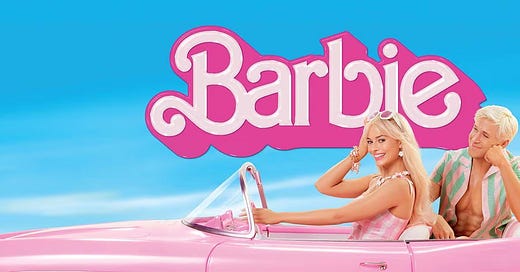I Am Not Going to the Cinemas to See Barbie Anytime Soon. Here’s Why.
Art as Advertising, Advertising as Art
“Barbie” the movie is the current phenomenon creating huge streams of genuine FOMO, especially when you are one of the last few who haven’t indulged in going straight into the cinemas yet. By now, the film has overtaken Harry Potter and the Deathly Hallows Part 2 as the highest-grossing global release in the history of Warner Bros. For those of you who have been living under a cave, in that, director Greta Gerwig explores the legacy of the controversial Mattel doll, opting to create a feminist icon out of a previous passive sex object/doll legacy.
In social media, the film had been generating hype for months resulting in a seemingly endless array of Barbie-themed events and brand merchandise along with a series of brand collaborations. In June, brand strategist Moshe Isaacian even started keeping track of the official partnerships on Twitter. A scroll through his Twitter thread shows about 50 partnerships but that's almost literally, half of it: So far, Mattel, maker of the iconic toy, has made over 100 brand deals for the movie –and counting.
As for fashion, the situation isn’t different either, According to Tess Garcia for Harpers Bazaar, “Barbie came to attract a remarkably diverse audience with an inclusive, star-studded cast, an intricate, green-screen-free set, and product collaborations ranging from rugs to roller skates. For many, Barbie has evolved into more than a movie. It’s a movement, and an excuse to go out with friends and dress the way our younger selves dreamed we would as adults.”A movement? Interesting.
But I am not going to cinemas anytime soon. Not only I am not tempted to be part of this giant bubble-gum-colored community, but I am in fact eager to separate myself from the hype. I want to experience the thrill of being an outsider. Let me elaborate. In a series of Tweets, Geoff Shullenberger, managing editor of @compactmag_ talked about Greta Gerwig’s film: “Barbie seems like a variation on what Zizek identified as the dominant structure of consumption a good while ago: the product that incorporates a critique of itself into the act of. It isn’t just ironic consumption, as it contains a moral dimension as well as an aesthetic one”
In that light, I know I will hate myself actually paying to view a commercial masked as a feature film. In that sense, historian Jill Lepore perfectly encapsulates my outrage when talking with Time magazine: “To pretend that a story about peddling plastic Barbie dolls for a giant international corporation is a story of feminist liberation, it's just almost unbearably sad to me. It's just a bizarre, creepy love letter to tyranny and capitalism.”
It is creepy because it is made into something else, something liberating, and at the same time, it grooms audiences to applaud a marketing so aggressive that it blunders the borders between cinema and pure consumerism. We are experiencing the use of an artistic excuse to create a fierce rebranding when the old story doesn't sell anymore. We are asked to pay to view it and then further fuel their well-built publicity machine by posting about it on TikTok.
Shullenberger is once more right here when he says: “The trick here is confusion; add everything in the mix and people will flock to set eyes of this magnificent one hour plus Mattel advertisement in the form of a film. Going back to Zizek’s theory, it is as if the Barbie movie confronts you with the superego demand to view Barbie as problematic in feminist terms, but simultaneously relaxes that demand by enjoining you to enjoy naively because the whole thing seems to correspond to a demand for regression to purer, more infantile modes of enjoyment, something also on view elsewhere in the culture; more cynical because no one is even pretending there’s a moral end being achieved here.”Simple as that.
So I am not going to go see the film anytime soon. Unless I get paid for it, of course.





